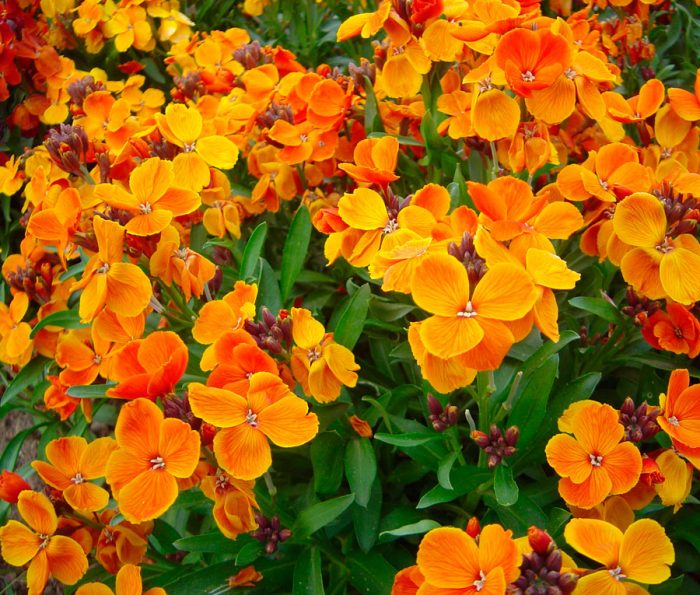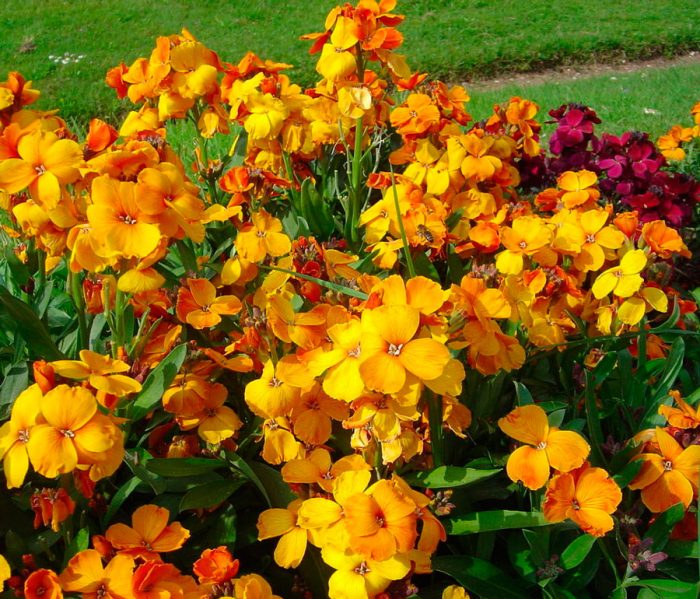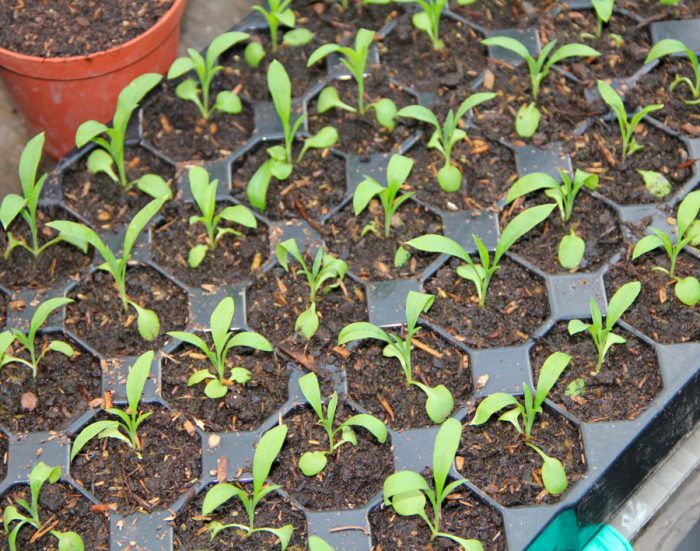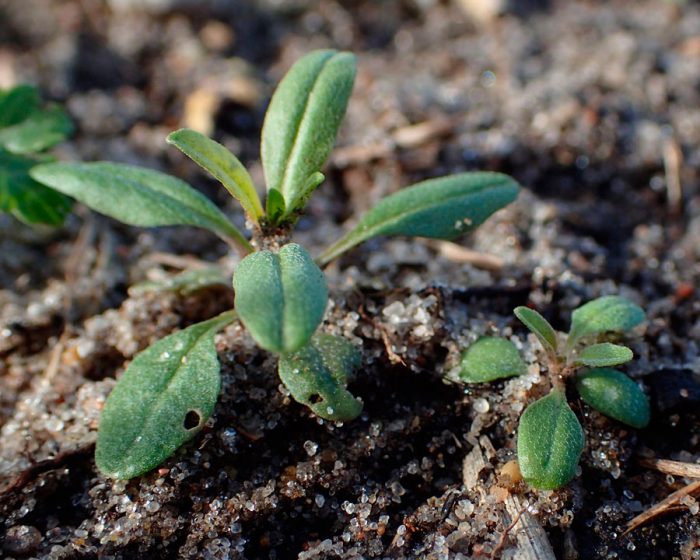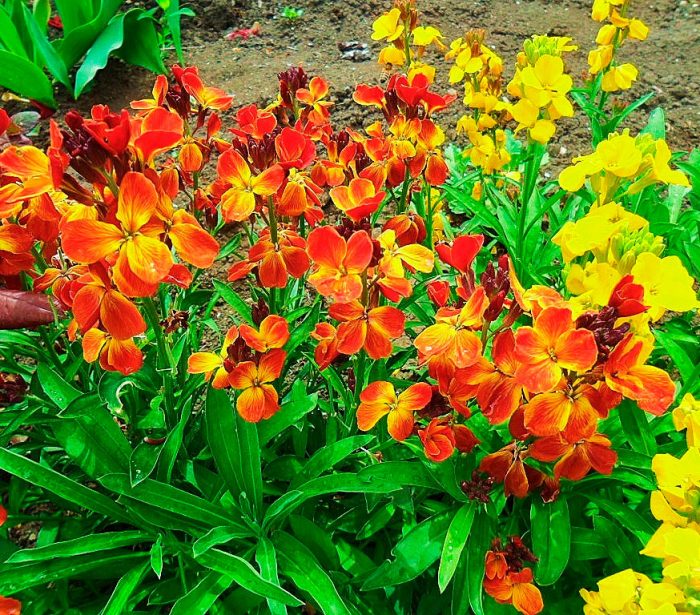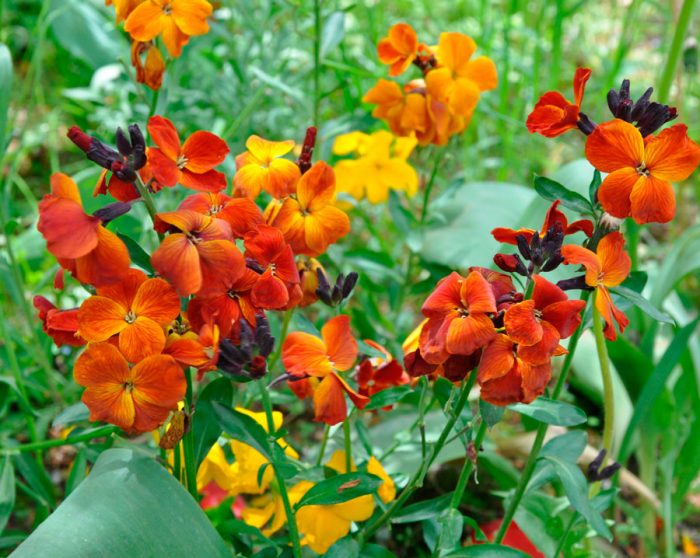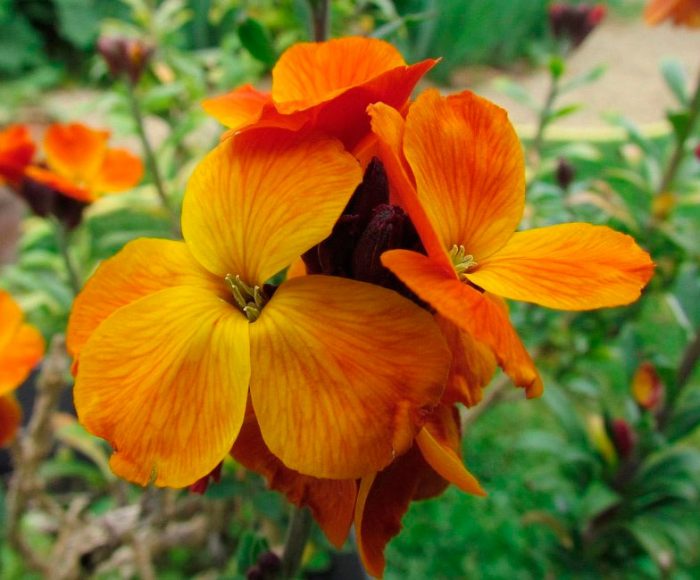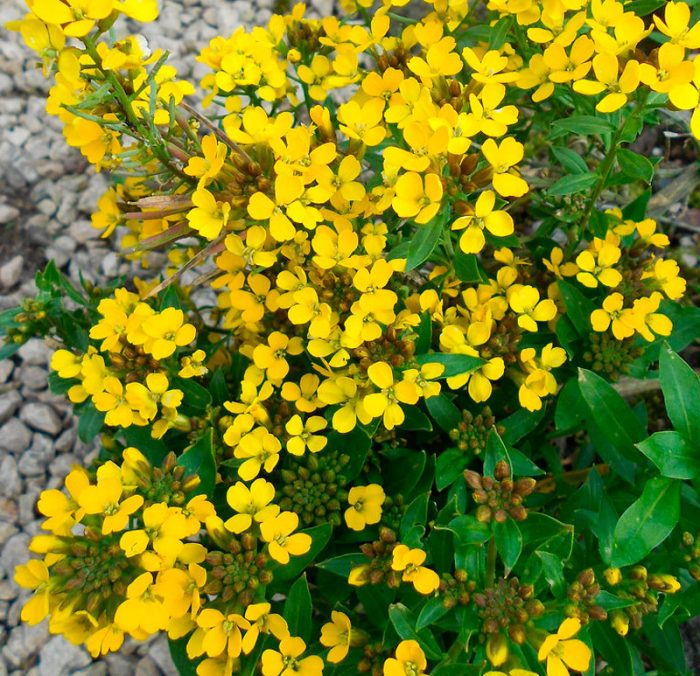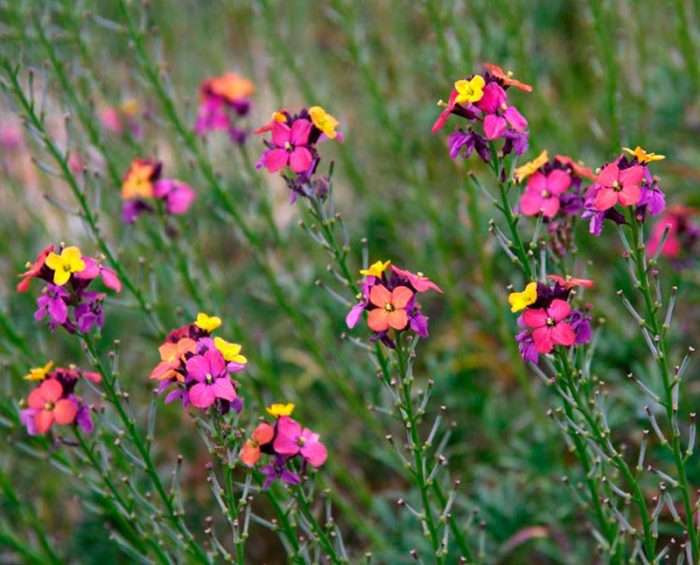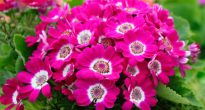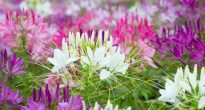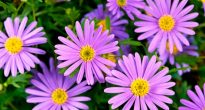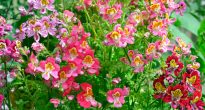The flowering herb Cheiranthus can be an annual, biennial and perennial, and it belongs to the Cruciferous family. It is also called jaundice, lacfiol, or yellowfiol. Not so long ago, this plant was very popular among gardeners. But today it is no longer so widespread.
Zheltushnik is able to decorate any flower bed. Its flowers are usually painted in warm yellow shades. That is why such a flower is also popularly called "yellow levkoy".
The homeland of such a plant is the Mediterranean. However, you can also meet it on the territory of the Crimean and Caucasus peninsulas.
Content
Features of Heirantus
On the surface of thin, weakly branching upright shoots, there is a slight pubescence. The bush can reach a height of 0.4–1 meters. The entire surface of the stems is covered with dense opposite foliage, which has an oblong shape. It has a bluish green tint.
Large racemes are composed of flowers, the four-petal corolla of which can reach 20 to 25 mm in diameter. They can be painted in a wide variety of shades of yellow. In addition, there are heiranthus with crimson, orange and dark red flowers. The inflorescences have a very pleasant smell.
When the bushes have faded, fruits are formed in place of the flowers, which are pods. Inside them are small brownish seeds (there are approximately 500 seeds in one gram).
Most varieties of jaundice bloom in the last summer weeks. However, there are also varieties that bloom from April to May.
Growing Heirantus in your garden is quite simple. It will be enough to follow simple agrotechnical rules, as well as provide the flower with timely minimal care.
Growing from seeds
Sowing seedlings
Sowing heirantus seeds for seedlings is carried out at the very beginning of the spring period. At the same time, grown seedlings are planted in a permanent place in the garden after about 2 months.
You will need a special seedling box or a wide container.To fill it, use a light soil mixture saturated with nutrients. Since the seeds are very small, it is recommended to combine them with sand before sowing. In this case, you will be able to sow them more evenly. Water the crops with a spray bottle, while on top they are covered with a transparent film or glass. Move them to a cool (16 to 18 degrees) place with diffused lighting. Do not forget to air the crops every day, and also water them from a sprayer if necessary. After the appearance of the first seedlings, the film is removed.
The picking of seedlings into individual small pots is carried out after 2 true leaf plates are formed in it. Seedlings are transplanted into the garden only after the earth and air have warmed up well (from about mid-May).
It is recommended to grow only annuals through seedlings, while biennial varieties and species are recommended to be sown immediately into the garden.
Sowing in open ground
In open ground, biennial seeds are sown in May. Level the surface of the previously dug area and distribute the seed evenly over it. It should be embedded in the soil with a rake, and then the crops are moistened from a watering can. The seedlings that appear need to be thinned, while the extra bushes can be transplanted to another place.
In regions with frosty winters in August, heiranthus is recommended to be dug up and planted in a pot, which is transferred indoors. This flower is able to withstand frosts down to minus 18 degrees, while adult bushes are more cold-resistant.
In regions with a warm and mild climate, jaundice is often sown before winter. And in such regions, it reproduces very well by self-seeding.
Planting Heirantus in open ground
Choosing a suitable site
For growing Heirantus, it is recommended to choose well-lit areas that have reliable protection from strong winds and drafts. Flooded and lowland areas are not suitable for planting. If, on the selected site, the groundwater lies very close to the soil surface, then a high bed should be built to plant the jaundice. Also, for planting such a plant, it is extremely undesirable to choose areas where crops belonging to the Cruciferous family were grown before.
The soil on the site must be fertile, pass water and air well, and also have an alkaline or neutral reaction. When about 15 days remain before sowing or planting Heirantus seedlings, you should dig up the soil to the depth of a shovel bayonet, while organic matter (humus or compost) is added to it.
Landing rules
Seedlings are planted in pre-prepared planting holes. Moreover, their size should correspond to the size of the root system. Plant a seedling in the hole and cover it with earth. When doing this, make sure that the root collar is flush with the soil surface. The distance between adjacent bushes can vary from 20 to 30 centimeters. The planted plants must be watered.
Heirantus care
Watering
Heirantus should be watered regularly and in moderation. At the same time, remember that such a culture is much easier to tolerate a short drought than stagnant liquid in the roots. It is recommended to moisten the soil only when its top layer is completely dry. Do not forget to systematically loosen the surface of the site and remove weeds.
Top dressing
For more lush flowering, the bushes must be fed in a timely manner. First of all, fertilizers are applied directly to the ground during the preparation of the site for planting the jaundice. After about half a month has passed after planting the seedlings in open ground, their first feeding is carried out. Perennial species and varieties are fed at the very beginning of the spring period. Also, the bushes need additional nutrition during the formation of buds. Organic fertilizers and mineral complexes are suitable for feeding Heirantus.
Trimming and pinching
In order for the bush to be more lush and well-branched, the upper parts of the shoots are regularly pinched. In order for new buds to form as soon as possible, do not forget to remove in time the inflorescences that have begun to fade. If you cultivate Heirantus as a perennial plant, then in the spring time all the dead stems are necessarily cut off from it.
Wintering
In mid-latitudes, it is recommended to cover the plant with a thick layer of mulch (flown foliage) for the winter. Remember that the bush can withstand a short-term drop in air temperature to minus 18 degrees. If the frost is more severe, this will lead to the death of the flower.
Diseases and pests
Diseases
Most of all, diseases such as:
- White rust or white rot... In the affected bush, foliage and shoots are damaged, and it loses its decorative effect. Cut out all affected parts of the plant and spray the bush with the fungicide solution.
- Keela... It damages the underground part of the bush, or rather, its roots. For prevention purposes, during the preparation of the site for planting, the soil must be lime. Also, do not allow the liquid to stagnate in the soil and do not add too much nitrogen to it.
Pests
An earthen flea, which is also called cruciferous, can settle on the jaundice. You can get rid of pests with the help of insecticidal preparations.
Heirantus in landscape design
Most often, heirantus is used for group planting in a flower bed. Beautiful inflorescences of warm colors look very impressive, while they cheer you up.
Such flowers also look great in mixborders, rocky gardens, rabatkas and rock gardens. For planting low-growing varieties of heirantus, baskets, containers or flower pots are often chosen. They can decorate a balcony, veranda or gazebo.
When growing jaundice in a flower bed next to it, it is recommended to plant heliopsis, tulips, linaria, Vittrock violets, poppies, alliums, daffodils, soapwort, forget-me-not or iberis.
Jaundice inflorescences smell very nice. Moreover, their smell is very similar to the aroma of lilac or night violet matiola. The plant is often used in the formation of flower arrangements. It is even grown commercially for cutting.
Types and varieties of lacfioli with photos
Alpine Heyranthus (Cheiranthus alpinus)
The bush reaches a height of about 0.4 meters. Its shoots are decorated with lush dark green foliage, while the flowers are yellow in color.
Cheiranthus cheiri
Plant height can be up to 60 centimeters. Flowers can be painted in various shades, namely: pale brown, purple, golden or dusty red.
Heiranthus allionii (Cheiranthus allionii)
This plant is a hybrid. Its large inflorescences are bright yellow in color.
Heiranthus mutabilis (Cheiranthus mutabilis)
The length of graceful shoots is about 0.8 m. Inflorescences are yellowish.
The most popular varieties among gardeners:
- Bedder... This is a series of hybrids, the height of the bushes in which varies from 0.3 to 0.4 m. Simple inflorescences can be colored orange, yellow or red.
- Zwerg... Such undersized hybrids are decorated with tricolor inflorescences. There is a variety of ZwergBusch: double flowers.
- Prince... Simple inflorescences can be colored in 5 different colors.
- Goldkonig... The powerful stem reaches a height of about half a meter. The bush is decorated with inflorescences, consisting of golden flowers.
- GoliathTreib... The vigorous bush is decorated with dark brown simple flowers.
- Linnaeus... Plant height is about 0.5 meters. Simple flowers are cream colored.
- Fire king... During the flowering period, scarlet inflorescences form on medium-sized bushes.
- The Snow Queen... This is a mixture of varieties, which includes only undersized varieties. They are highly frost-resistant.


Watch this video on YouTube

